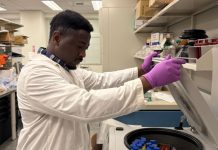In this interview with Our Reporter a Nigerian researcher residing in the United States of America, Abiola Lawal, sheds light on his research work targeting reduction of greenhouse gases in agriculture, what spurs it as well as what effects it might potentially have on animal production and environmental sustainability.
ENM: Can we meet you?
Lawal: My name is Abiola Lawal, a PhD student at Purdue University in Indiana, USA. Originally from Nigeria, I moved to the United States after completing my bachelor’s degree to pursue advanced studies. I am deeply passionate about research, environmental sustainability, and animal production. My ultimate goal is to contribute to a future where food security is achieved without compromising the integrity of our natural resources.
ENM: Can you share a brief overview of your academic journey, starting with your bachelor’s in animal science in Nigeria and your transition to graduate studies in the U.S.? How did these experiences shape your interest in swine nutrition and environmental sustainability?
Lawal: I was born into a family where animal agriculture was our primary means of livelihood. Pursuing a degree in Animal Science at Ekiti State University felt like a natural choice. As a teenager, I helped my parents care for their poultry and often wondered how to improve animal production while effectively managing the resulting waste. Over time, these questions fueled a passion for finding solutions. By the end of my undergraduate studies, I had been exposed to sustainable agriculture, which deepened my interest in environmental science. This interest led me to pursue a master’s degree in environmental science at Miami University,where I gained practical knowledge about reducing the environmental footprint of human activities, including animal production. After completing my master’s program, I worked for the Ohio Department of Agriculture as a plant health inspector. Driven by my passion for research, I transitioned to Purdue University, where I am currently pursuing a PhD in animal nutritional physiology. In my PhD research, I am combining my expertise in animal production and environmental science to address the challenge of excess nitrogen waste in animal feces. My goal is to develop sustainable nutritional strategies that balance production efficiency with environmental responsibility.
ENM: How did your experience working as a plant health inspector at the Ohio Department of Agriculture influence your approach to animal production and sustainability in your current research?
Lawal: My time at the Ohio Department of Agriculture (ODA) as a plant health inspector gave me valuable insight into the broader agricultural industry, particularly in terms of regulatory practices and the importance of sustainable management. While my role focused on plant health, I developed a deeper understanding of how agricultural practices, especially waste management and pesticides use, can have far-reaching environmental consequences. Witnessing firsthand the effects of improper waste management and the overuse of pesticides underscored the urgent need for more sustainable practices within the industry. It became clear that the choices made at the farm level echo throughout ecosystems, affecting soil health, water quality, and biodiversity. This experience reinforced my commitment to finding solutions that minimize negative environmental effects in agriculture. It also helped me appreciate the importance of collaboration between different sectors to ensure a more sustainable and integrated approach to food production. It is not enough for farmers and regulatory bodies to work in isolation; a holistic and integrated approach is essential to ensure a sustainable food production system. As trends in agriculture often overlap, addressing environmental concerns requires collective action from stakeholders across various fields, including policy, environmental science, and public health. Overall, my role at ODA was not just a job, it was a transformative experience that deepened my understanding of the complexities of agriculture and strengthened my resolve to contribute to sustainable food systems.
ENM: What inspired you to focus your PhD research on low protein diets for nursery pigs? Was there a specific problem or gap in the field that drew your attention?
Lawal: The production of animals for meat, while essential for global food security, poses significant environmental pollution challenges. For example, nitrous oxide emissions from pig manure are a substantial contributor to greenhouse gases in animal agriculture. Its global warming potential is nearly 10 times greater than methane and almost 300 times greater than carbon dioxide, making it a critical factor in climate change. In addition to nitrous oxide, animal agriculture releases ammonia and nitrogen oxides, which contribute to air pollution, acidification, and eutrophication, posing risks to both human health and the environment. The first gap my research aims to address is optimizing animal production while reducing its environmental burden. Low-protein diets have long been used by farmers to control post-weaning diarrhea in pigs, a common challenge in swine production. However, while effective for managing diarrhea, these diets often compromise growth performance. The second gap my research seeks to fill is to develop strategies to control post-weaning diarrhea without sacrificing growth. By supplementing low-protein diets with ingredients such as nucleotides, I aim to strike a balance between animal growth and environmental sustainability, addressing both challenges simultaneously.
ENM: Your research integrates animal nutrition with environmental concerns. Can you explain how reducing nitrogen excretion in swine production aligns with broader goals in sustainable agriculture?
Lawal: The intersection of animal nutrition and environmental sustainability has become increasingly crucial, particularly in swine production. This is because it not only improves the efficiency of nutrient use but also aligns with broader goals of sustainable agriculture. For instance, nitrogen excretion contributes significantly to soil and water pollution, particularly through nitrate leaching and eutrophication of water bodies, which harm aquatic ecosystems and can threaten human health. In addition, nitrogen emissions, such as ammonia and nitrous oxide, contribute to air pollution and climate change. By optimizing nitrogen utilization through nutritional strategies, my research aims to reduce these environmental impacts while maintaining or even improving animal growth. This aligns with sustainable agriculture’s goal of balancing productivity with ecological responsibility, ensuring that food production systems can meet current needs without compromising resources for future generations.
ENM: What practical steps or guidelines could your research provide to pig producers looking to adopt sustainable feeding practices without compromising production efficiency?
Lawal: My research provides actionable insights for farmer and animal producers seeking to adopt sustainable feeding practices without compromising production efficiency. One practical guideline involves the strategic use of low-protein diets supplemented with nucleotides to reduce nitrogen excretion, minimize post-weaning diarrhea, and maintain optimal growth performance in pigs. By improving nutrient utilization and reducing environmental pollutants, these strategies offer a win-win for farmers and the planet. I ensure that the findings from my research are shared widely through publications in peer-reviewed journals, conference presentations, and producer-focused extension materials. This allows farmers and producers worldwide to stay informed about the latest advancements and adopt science-backed strategies tailored to their operations. Ultimately, the goal is to bridge the gap between research and practice, empowering farmers and producers to enhance sustainability while maintaining economic viability.
ENM: How do you envision the broader application of your research findings? Could these dietary strategies be adapted for other monogastric species or scaled globally?
Lawal: For other monogastric species like poultry, similar issues of environmental pollution and inefficient nutrient utilization exist. By adapting and testing these strategies, we can potentially improve their growth while reducing environmental impact across multiple species. To be specific, poultry production also faces challenges with ammonia emissions, and nutritional strategies such as nucleotide supplementation of low protein diets could enhance protein utilization efficiency, much like in swine. On a global scale, these strategies are particularly promising. Regions with intensive livestock production and environmental constraints could benefit from these approaches. Moreover, the increasing demand for sustainable agricultural practices makes this research adaptable across different production systems worldwide. Through collaboration with industry stakeholders and ongoing research, I envision scaling these findings to fit diverse production environments, ensuring they are both practical and economically viable for producers globally.
ENM: Looking ahead, what are the potential challenges or areas for further research in developing environmentally friendly and economically viable diets for livestock?
Lawal: One major challenge is balancing the trade-offs between environmental sustainability and production efficiency. For example, while low-protein diets reduce nitrogen excretion, they can compromise growth performance if not carefully supplemented. Research must continue to explore additives like nucleotides or other bioactive compounds that can maintain or even enhance animal productivity in low-protein systems. Another challenge lies in the cost and accessibility of alternative feed ingredients or supplements. While synthetic amino acids and nucleotides show promise, their cost-effectiveness for large-scale implementation remains a concern, particularly for smallholder farmers in developing regions. Future research should focus on reducing production costs for these supplements and identifying locally available, sustainable alternatives. From a broader perspective, adapting these diets to different species, production systems, and geographical contexts poses its own set of challenges. Regional differences in feed ingredient availability, climate, and regulatory frameworks mean that solutions must be tailored to specific conditions. Lastly, effective knowledge transfer and adoption by producers are critical. Research findings must be communicated in practical and accessible ways to ensure they are implemented on farms. This requires ongoing collaboration between scientists, extension specialists, and industry stakeholders.
ENM: What advice would you offer to someone aspiring to pursue a career in your field?
Lawal: Aspiring researchers should embrace interdisciplinary learning, gain practical experience, and build a strong professional network. Additionally, staying informed and adaptable is crucial for success in this field. While the path may be challenging, the opportunity to contribute to science and protect our planet makes it all worthwhile.










